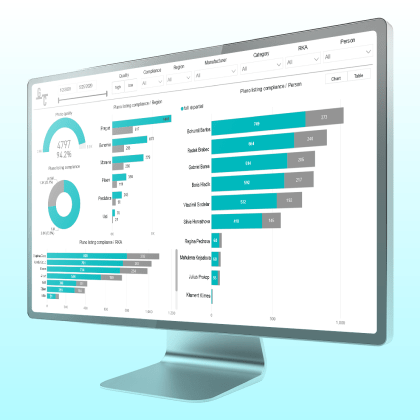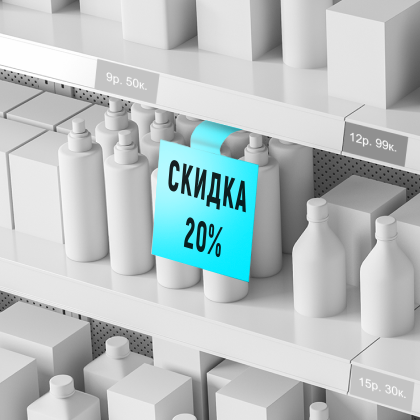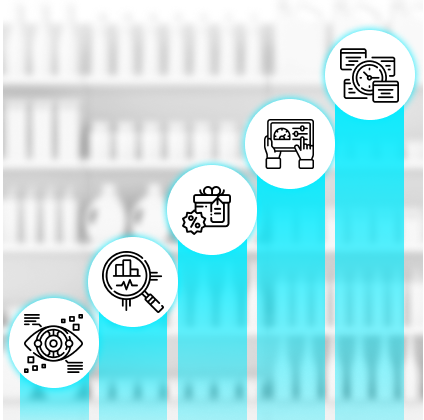Table of Сontents
Why analytics matters

FMCG companies are good at analyzing sales at the store level: how the product is sold, the percentage of defective goods, which brand is more popular, and which is less. This is a common practice. But not everyone is able to analyze what happens to a specific product on a specific shelf.
What does shelf analytics bring?
- Understanding of what percentage of time a product is out of stock. Not having a product on the shelf equals a loss of revenue. Therefore, it is essential to know how often buyers fail to find your product and how this affects sales.
- Improved customer experience. FMCG products are the category of goods that fly off the shelves. Shelf analytics will help you calculate how quickly the product is sold out and when you need to put it on the shelf and place an order for the warehouse.
- Increased sales in the store. By starting to analyze the shelf, you understand what percentage of the time the product is not available to the buyer, what share of the shelf your product occupies, which product is sold out more often and how the display performs. The answers to these questions will help you display products to direct the buyers’ attention to them.
Making analytics more efficient

For analytics to be more efficient, it is essential to track certain KPIs, enhance monitoring of planogram compliance, and speed up the reporting process.
Step 1. Display management with artificial intelligence.
Merchandisers generally check the layout. They come to the store, compare the location of the goods on the shelf against the planogram, correct it, take a photo of the shelf for a report, and go to another outlet. This process has several weaknesses.
The first is the human factor (fatigue, lack of diligence, lack of time). According to statistics, tools for automating the process of comparing layouts against planograms help not only reduce errors and significantly speed up the process, but also discipline and motivate the merchandiser. The app shows where and when the employee took the photo. It also shows correct and incorrect placement of goods and missing goods in the photo. Leaving the store, the merchandiser can state with confidence that the job was done well.
The second is the time lag between sending the report by the merchandiser from the store and analyzing this report by the manager. It often takes a long time before the report is processed. This means that the data in the report has already lost its relevance.
As a result, the company receives inaccurate data which is used to build analytics and make managerial decisions.
Today, the IT solutions for display analysis came into use at FMCG companies. For example, the Goods Checker app is powered by artificial intelligence. It compares a photo of a shelf with a planogram and finds incorrectly displayed or missing products, generates detailed analytical reports for managers and helps to understand the display performance. It also allows determining your share and the competitor’s share on the shelf.
Step 2. Monitoring the shelf share in the store
It is important to analyze the share of goods on the shelf. This will help evaluate the performance of employees (product managers, customer relationship manager, merchandisers and others) and monitor the compliance with obligations by retailers and distributors.
Knowing your shelf share and your competitors’ shelf share, you can understand how to increase your ratio, optimize and organize products on the shelves more efficiently, and maximize turnover.

Step 3. Monitoring of promotional and informational materials on the shelf
FMCG companies hold promotions; they highlight their products on the shelf using stickers, wabblers, and other tools. POS materials are essential for sales: they draw the buyer’s attention to the desired product, provide information about the new product, promotion or discount and, accordingly, increase sales. Therefore, they must be constantly monitored. This is because the lack of POS materials may result in a decrease in sales and subsequent incorrect analytics of the entire marketing campaign.
The company needs to understand whether these POS materials work or not. Analytics will help answer this question and find out how correctly promoted products are presented on the shelf, and what needs to be done to push up sales of these products.
Step 4. Checking the out-of-shelf and out-of-stock
Lack of goods on the shelf is a direct loss for an FMCG company. Therefore, it is important to track out-of-shelf and out-of-stock metrics. Merchandisers need to note in their reports whether the product was displayed on the shelf. If not, then the reason should be specified: out of stock, store employees failed to put it on the shelf, the space is occupied by another product, etc.
This data will help improve the logistics process, coordinate the location of goods on the shelf with the store and address other issues so that the layout matches the planogram.
Step 5. Manager receives information in real time
Managers receive a lot of photos and other data from merchandisers. They have to check all the photos in order to objectively and accurately evaluate the work done, to bring all the data together. Based on the reports, managers would like to understand the layout performance and market positions of the company and its competitors.
FMCG companies automate the processing of photos and reporting. Automation helps improve the quality and speed of the process. For example, with Goods Checker, managers no longer need to process photos manually, as the application handles this automatically. Marketers obtain detailed and timely analytics with breakdown by stores, goods, merchandisers in near-real time.
Automation is the First Step to Successful Analytics
KPI analysis and automation will help to identify bottlenecks in the processes of an FMCG company: relations with retailers, logistics, sales, merchandising, etc. By receiving real-time analytical data, you can quickly respond to market changes, pick up on new trends earlier than competitors and understand the demands of the consumers more accurately.
All of these things will help to obtain more timely data for making managerial decisions and increase sales, and hence profits.




